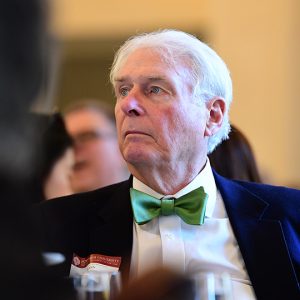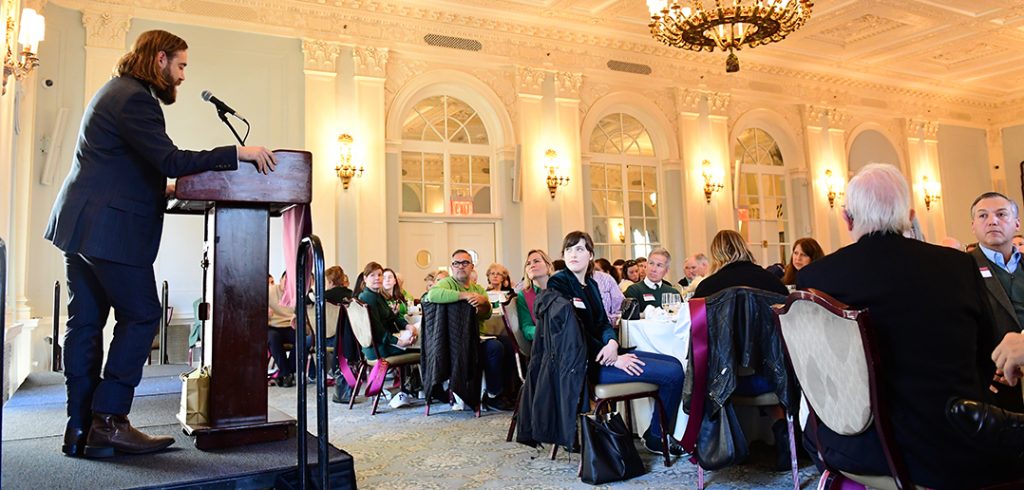
“There is a touch of the melancholy about us to be sure—I mean in my family no one was ever happy unless they were unhappy,” Joseph M. McShane, S.J., president of Fordham, said to much laughter at a breakfast at the Yale Club organized by Office of Alumni Relations. “I don’t know what it was all about, but I knew it was a part of who we were.”
Trustee John Lumelleau, FCRH ’74, a breakfast guest, could relate. He recalled his Irish grandmother who dealt with her hardships as easily as joy.
“My dad’s mother was a woman who was not deterred by anything and had setbacks in her life as a child, but had a very robust adult life,” he said. “She was a woman who liked to laugh, but she could just as easily wear a frown.”
Outside, waiting for the parade to start, Fordham College at Rose Hill junior John Patterson noted, as had others, that “Danny Boy” is hardly a pick-me-up melody.
“’Danny Boy’ is a really sad song, but I never thought of it that way,’” he said with an unmistakably Irish smile before shifting to a celebratory note. “Everybody gets to be Irish today. So many people claim to be Irish, and everybody gets to be a little bit Irish today.”
Nearby, the Harrison High School marching band warmed up with “Sweet Caroline,” a girl’s baton troop mugged for cameras, and the Nassau County Police Emerald Society of Pipes and Drums readied for Fifth Avenue. Just a stone’s throw from Fordham’s lineup position stood the contingent from Manhattan College. Needless to say, there was some good-natured teasing between alumni groups, who were once arch-rivals in football.

The Oldest Irish Studies Program, Founded by a Stranger
At the breakfast, Cathal Pratt, a Fordham Ph.D. candidate in English, told the somewhat-sad tale of the Irish nationalist Joseph Campbell. Campbell, a self-taught poet, anchors Fordham’s claim on having the oldest Irish Studies program in the world, which he initiated in 1925.
“Other American universities had chairs of Celtology, but Fordham was the first school of its kind devoted to research in the Irish arts as a whole,” Pratt said of the program.
“[Campbell] spread culture throughout the campus—reminding Fordham of our Irish heritage,” he said. “Reportedly, he was a sight to see, often walking the grounds in a kilt.”
After political imprisonment and a failed marriage, Campbell came to Fordham with an infectious love of Irish poetry and literature, which he spread by teaching no less than six classes a week while running the Irish program. His enthusiasm was appreciated, but his lack of academic credentials was not and he was eventually let go. The program disappeared with him in 1938, but would eventually be reestablished in the Department of English in 1998.
“He was even told that parts of his previous work were tolerated ‘out of charity’ for his impoverished condition,” said Pratt. “Campbell’s dreams died then, and he went back to Ireland, to a small farm, where he would stay for the rest of his life, working on radio histories that chronicled his journey.”
Campbell’s story should not be read as a “boot-straps story,” Pratt said, but rather his story should inspire “because he failed in America—so many do.”
“Look to when we [Irish] were strangers, to when we too failed. When we were not met with compassion,” he said. “But we are not held to this past.”
He noted that St. Patrick was also a stranger, “marked by difference” as an English slave with a foreign religion. As the Irish welcomed St. Patrick, and America eventually welcomed the Irish, Pratt said it’s the responsibility of the Irish to continue to make strangers feel at home.
“We have been storytellers. Scholars. Soldiers. But most importantly, we have been strangers. And it is our solemn duty and honored privilege to welcome those foreign to us, for we share a common past,” he said. “So, if, as they say, on St. Patrick’s Day everyone is Irish, then, well, everyone is or has been born of a stranger. And I pray that none of us feel like it.”
[doptg id=”140″]Strangers Welcome Among Us
Father McShane underscored Pratt’s point that strangers often enhance their newfound homes, sometimes shifting the culture.
“St. Patrick was a stranger, but he created a culture a culture of charity, a culture of respect for others, and a culture that was at its heart prayerful, that knew that the Lord was a stranger, and that we were all strangers,” he said. “But it is in giving [to strangers]that we derive our greatest joy.”
Later, while waiting for the 258th marching of the parade to start, Tara Maney, FCRH ’91 and Tammy Maddalla, FCRH ’89, pondered what it is to be Irish and a Fordham Ram.
“To be Irish is to be kind, to be generous, to be down-to-earth, and wholesome,” said Maney. “But I don’t think of Fordham as only being Irish or Catholic. It is more of a blend.”
Maddalla agreed.
“I like the notion that we’re all strangers; I like to think of America as welcoming,” she said. “And at Fordham, it’s about being a Fordham family, really. It’s not about nationality. It’s a family.”
As the Fordham contingent hit Fifth Avenue, the warm sun streamed brightly from the south, allowing participants to eschew winter coats and display their Irish tweed and fisherman’s sweaters as they chanted:
“We are Fordham!”

